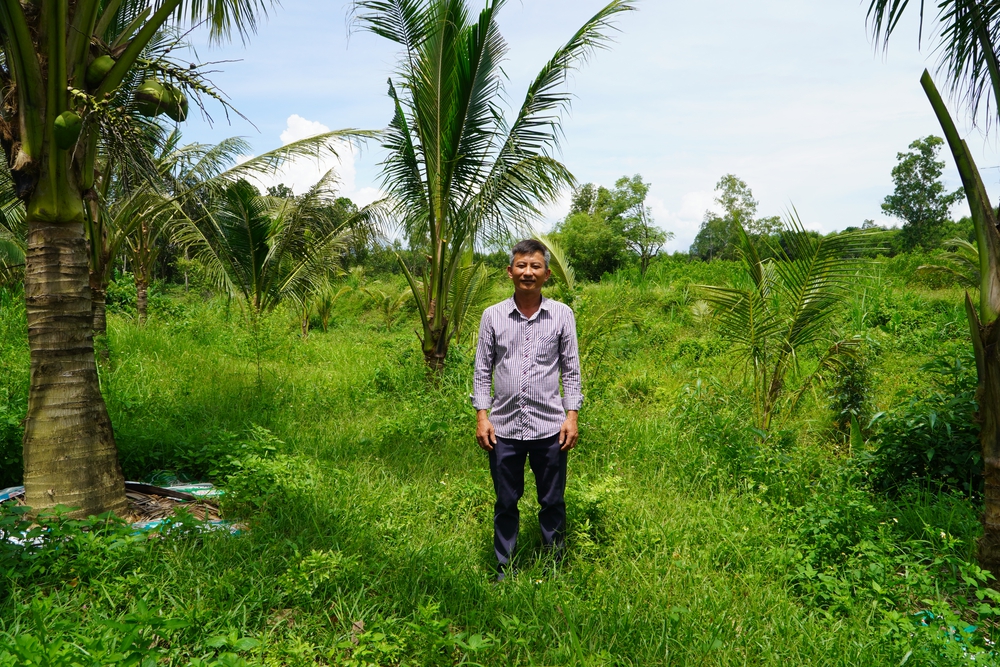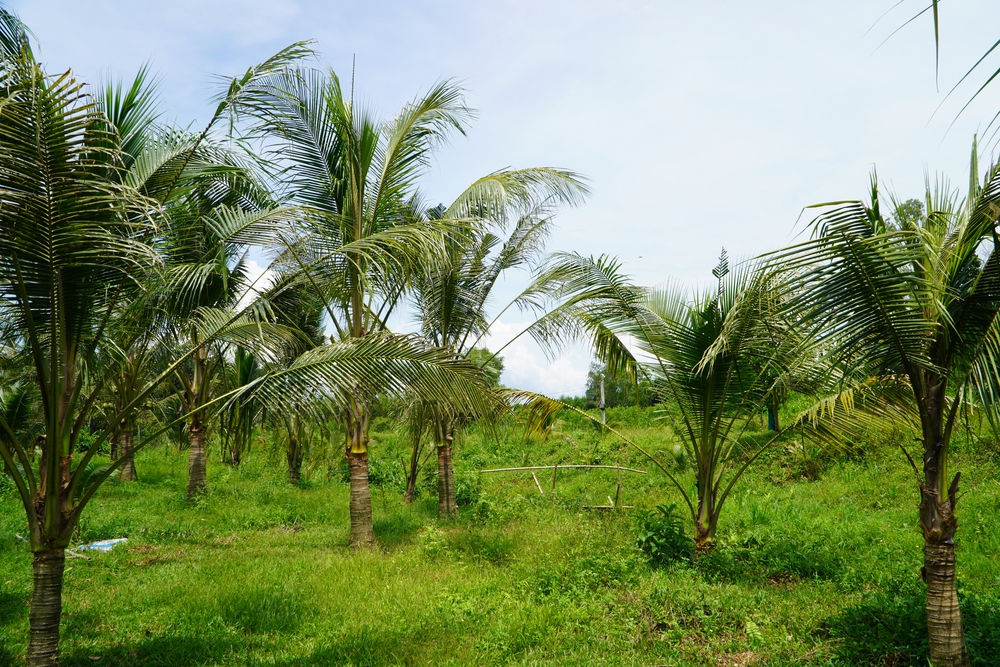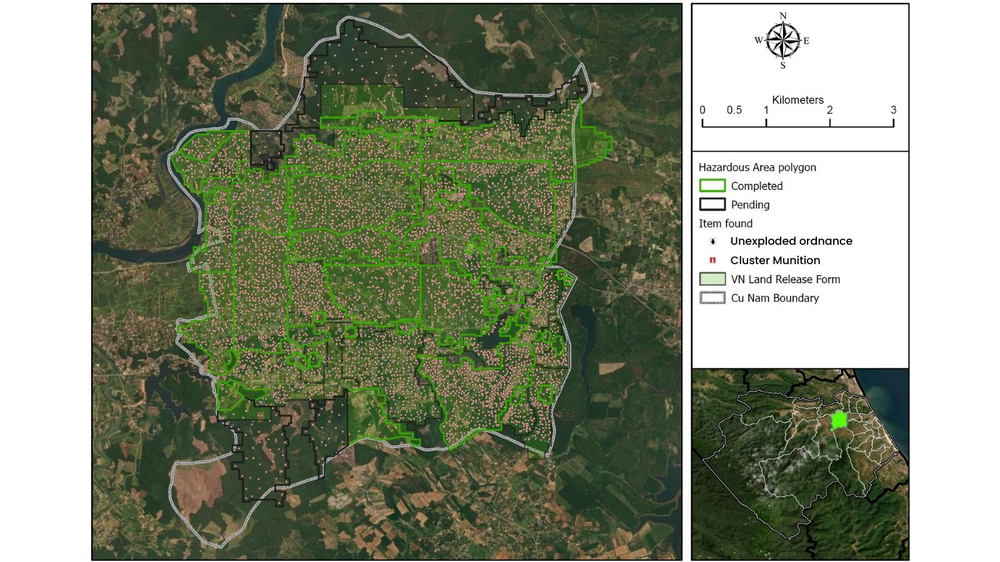Located in central Vietnam, Cu Nam commune was once heavily affected by war.
According to U.S. bombing data, the commune alone was hit by 765 bombing missions during the conflict, leaving behind unexploded ordnance (UXO) that continues to threaten lives and livelihoods long after the fighting ended. UXO is found both on the surface and buried deep underground, posing serious risks to farming, construction, and daily life.
Over eight years, beginning in 2015, MAG launched a comprehensive demining effort in Cu Nam at the request of the Quang Binh Provincial People's Committee, with vital support from the U.S. Department of State.
MAG has safely cleared more than 22 km² of land, representing approximately 71% of the commune’s total area, and removed and destroyed 11,158 explosive items.
This clearance has allowed local communities to reclaim their land with confidence, paving the way for new opportunities, including a growing shift toward sustainable, community-led tourism.
Two local families in Cu Nam demonstrate how safe land has transformed opportunity into action:
The Quang Family: Coconut Garden Restaurant
Quang and Bieu’s 35,000 square metre plot was once a place of caution and limited hope.
For years, the family relied on melaleuca trees, a hardy species that did not require deep digging, making it suitable for land they feared might conceal UXO. More than half of their land remained untouched, abandoned out of fear of what lay beneath. “We didn’t dare bring machines to clear the land behind our house,” they said.
Each harvest, which came every five years, brought in 35 million VND (approximately $1,400 USD) after expenses. It was barely enough to cover basic living costs and provide for their three children. “We were constantly worried. How could we afford school fees?” Quang recalled.

To make ends meet, both he and his wife often had to leave home for seasonal work, relying on their elderly parents to care for the children.
Everything changed in 2020, when MAG completed clearance operations on their property. With peace of mind restored, the family began to reimagine the future. They decided to shift from melaleuca to more productive crops, planting over 600 coconut trees and introducing pine trees on the hillside behind their home.
“We chose coconuts as we could finally dig deeper, something we'd never dared before," said Quang. "Planting coconuts required digging holes 70cm deep and one metre wide, an impossible task on uncleared land."

Initially, coconut sales brought in around 20 million VND per year, a modest start but a promising one. Encouraged by the lush growth of their trees and the peace of mind that came with safe land, the family dared to dream bigger. “The garden started looking greener and more beautiful,” Quang shared. “That’s when we thought, why not create a space where people can come enjoy this with us?”
In 2023, that idea took shape as Coconut Garden Restaurant, a small, home-style eatery nestled among the trees. The restaurant quickly found a following among visitors eager for peaceful, nature-based experiences.
“We never imagined ourselves working in tourism. This land used to be dry, hard, and dangerous. Who would want to visit?” Bieu said. “But now, our community looks greener, more developed, and tourists want to be part of that.”

By 2024, the restaurant was generating an average of 15 million VND (approx. $600 USD) per month, nearly triple what they earned in a year from melaleuca farming. It also allowed the couple to stay close to home, raise their children themselves, and build a stable, long-term livelihood.
They also planted pine trees on the hillside behind their home, not only to prevent erosion during heavy rains, but to enhance the natural scenery. With safe land beneath their feet and a thriving business rooted in nature, the Quang family is finally making full use of their land’s potential.
The Hieu Family: Hilltop retreat
After many years working in Ho Chi Minh City, Hieu and his wife made the life-changing decision to return to their hometown of Cu Nam in 2020. Their first step was purchasing a plot of land to build a home for their family and to realise a bigger dream: developing an eco-friendly destination rooted in the changing landscape of their community.
When they returned in 2020 after eight years away, the difference was striking. “Cu Nam looked entirely different,” Hieu recalled. “There were more trees, greener hillsides, and a sense that the land was being brought back to life.”

Hieu saw growing potential in the area’s proximity to well-known tourist attractions like Phong Nha Cave and began to believe that tourism might offer a new future for the village and for his family.
Equally important was the knowledge that the land had been cleared of unexploded bombs by MAG in 2020.
“That was a decisive factor,” he said. “We couldn’t build anything unless we knew the ground was safe. Not just for our children, but for future guests.”

In 2022, their project, named ‘Đồi Mây Đắng’, officially opened. Designed as a serene hilltop retreat, it quickly became a unique destination in the region, offering camping, outdoor experiences, and green open space for visitors looking to connect with nature. Since then, it has welcomed an average of 6,000 visitors per year. The site not only provides the family with a stable source of income but also creates jobs for neighbours and contributes to the growing tourism network in Cu Nam.
What was once land marked by caution and uncertainty is now a space of opportunity and pride. For Hieu and his family, safe land meant more than building a house. It meant building a future and inspiring others in the community to see the value of what lies just beneath their feet: potential.
A community transformed
The story of Cu Nam goes beyond individual families. With the support of the Quang Binh provincial government, a broader community initiative is taking shape: the development of Cu Nam Cultural Tourism Village.
This initiative promotes community-based, sustainable tourism that emphasizes environmental protection, cultural preservation, and inclusive economic growth.

According to the People’s Committee of Cu Nam, from 2021 to 2024, the commune has welcomed 341,620 visitors, generating over 33 billion VND (approximately USD $1.3 million) in tourism revenue. Tourism now accounts for 60 percent of the commune’s total income structure.
“To develop tourism, safety must come first. We are proud that 71% of our commune, especially the residential areas, has been cleared of UXO,” said Luong, Chairman of the Cu Nam Commune People’s Committee.
“In the past, Cu Nam was only known for farming, and most of us couldn’t imagine anything different. Now, thanks to safe land, we’re building a tourism economy that helps the whole community.”
Learn more about MAG's work in Vietnam here.





